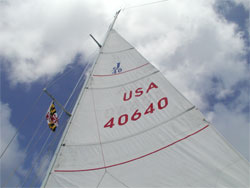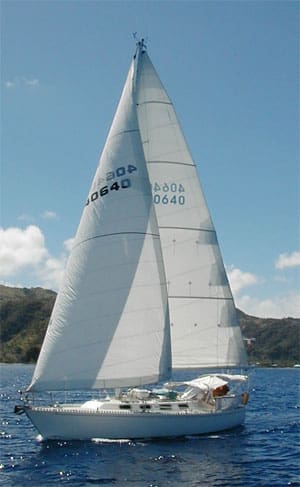To the editor: A sailmaker gave us some advice one time when asked how we should care for our mainsail: “Sail hard. Put it away wet. And come see me in a year.” Maybe not every year, but replacing the mainsail of a cruising sailboat is one of those unavoidable expenses for any long-term voyager. In the 16 years that we’ve owned our J/40, Gryphon, we’ve had two new mainsails built and our third is now in construction. I thought our experiences with the first two sails — and the decision that they led to for the third — would be interesting for others looking at the same choices.
Our first new mainsail was built in 1998, one year after purchasing Gryphon and about six months before setting off on our bluewater voyage. Our priorities for the sail were that it should be rugged, durable, and manageable by a crew of two. The J/40 has a large sail area for a boat of its length (439 square feet); with a conventional hoist and on-boom reefing and flaking, the mainsail can be a handful with one person on deck and one handling the halyard.
We chose Thurston Sails of Bristol, R.I., — a Quantum loft — to build the sail. The sail was of conventional Dacron, the 8.6-oz cloth providing strength and durability without adding undue weight. The design was crosscut and the construction was heavy-duty with an eye to offshore work.
 |
|
Jeff Williams |
|
The second sail was built from a cruising laminate. |
We put the sail into service in June 1998 for the Newport Bermuda Race (an extremely light wind affair that year) and it remained our sole mainsail until we completed our circumnavigation in Antigua in April 2004. It sailed more than 40,000 miles in those six years in all kinds of weather. With its deep third reef, we were even able to use the sail in storm conditions.
Over the years, we had the sail serviced numerous times — chafe on shrouds, leech cord abrasion, and just general wear-and-tear required patches and sail tape from time to time. In the end, the cloth was so worn that we could see sunlight through it in thousands of pinholes; the material was limp and thoroughly stretched. Nothing of the original sail shape remained. But it still worked, especially downwind. Climbing the wind was a struggle.
Of course, the changes to the sail’s condition — and to Gryphon’s performance — evolved slowly over the years and we didn’t realize the dramatic loss that had occurred. Not until we replaced the sail with its brand new successor, that is.
Our second mainsail was also built by Quantum, this time in Cape Town, South Africa. This sail was built in tri-radial form using a cruising laminate (no exotic fibers) sailcloth. Otherwise, the features of the sail were virtually identical to the first.
We’re not competitive racers (except of course when there’s another boat in the same ocean) but we have come to enjoy the challenges of tweaking that last quarter-knot out of Gryphon. Suddenly we found ourselves with a fresh performer — a boat that would once again respond to subtle trim changes.
It was this sail that we used for several years of cruising in the Caribbean, our second Pacific crossing, and a couple years of weekending around New Zealand’s North Island. The sail was in use for nine years — though to be fair two of those years were spent tied to a dock with the sail safely tucked in the aft cabin. So, in seven years of use, the sail was used for about 20,000 miles of sailing, the latter 10,000 being the tougher and more intense by far.
Four years into the working life of the sail (six years after its build) we saw significant areas of delamination starting. Mildew had been present between the laminates for a few years, but now we were seeing the layers starting to separate.
In spite of this, we managed a first place in one race of the BVI Spring Regatta. Clearly the sail still had enough of its original shape to perform well.
During the trans-Pacific leg, however, more panels of the sail delaminated. The good news was that with a tri-radial construction, none of the panels were very large and so the delamination always stopped at the seams.
Repairing the sail became more of a challenge however. We had long passed any sense of vanity for the sail’s appearance — conventional Dacron patches covered the sail like an old quilt. Ironically even a piece of the original mainsail went on as a patch in Tahiti — new sailcloth being prohibitively expensive there.
Rough handling of the sail would lead to rips and more repairs. Duct tape was added in crucial spots. It looked silly, but it got us to New Zealand. And it worked for two more years in that patchwork state before we finally admitted the sail was past its “use-by” date.
So, facing the prospect of a new build, what did we learn from our experience?
In fact, both sails — the Dacron and the laminate — lasted through about six years of use before we replaced them. At the end of those years, the Dacron sail still looked like a sail; the laminate, not so much. The Dacron sail could have still gotten us through one more passage, providing the weather was fair and the seas kind. The laminate — maybe.
On the other hand, at the end of its useful life, the laminate sail still had some semblance of the shape its creator intended. The Dacron was little more than an amorphous rag hung from the headboard. A tear in the Dacron sail could extend the full width of the sail (and often did); a failed panel of laminate material was still surrounded by comparatively sound material, limiting the extent of the damage. And, a delaminated panel is still a panel (of sorts).
Our conclusion is that six years is about the useful life expectancy for a cruising sail (given our boat, our cruising style, etc.). Having accepted a six-year tenure for the sail’s usefulness, either material serves well. If the intention is to stretch this life to 10 years — and if performance is of little or no concern — Dacron is clearly the better option.
The laminate comes with a price premium (about 10 to 20 percent based on our recent quotes), but it pays back with lighter weight and improved performance (read less time on long passages) over the long term. As delamination begins to occur, these failures are constrained to small panels. But when it’s done, it’s done — no 10-year tenure for the laminate.
In the event, we chose another cruising laminate for mainsail number three. We have no plans for another circumnavigation and in six years time expect to be no farther away from home than a seven-day passage admits. In those six years, we’ll enjoy the incremental performance benefit — shorter passages, less foul weather, and maybe winning a race or two — and pay for it with more expensive (and ultimately less elegant) repairs.
Your choices will be based on your boat, experience, and expectations. Either sailcloth will take you across oceans and into great adventure.
—Jeff Williams and his wife Raine live in New Zealand. Williams is currently finishing a stint working aboard the NOAA oceanographic research ship Okeanos Explorer (oceanexplorer.noaa.gov).

